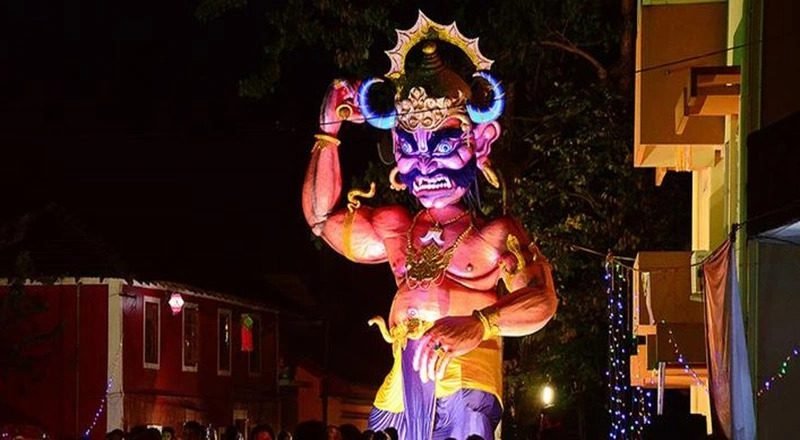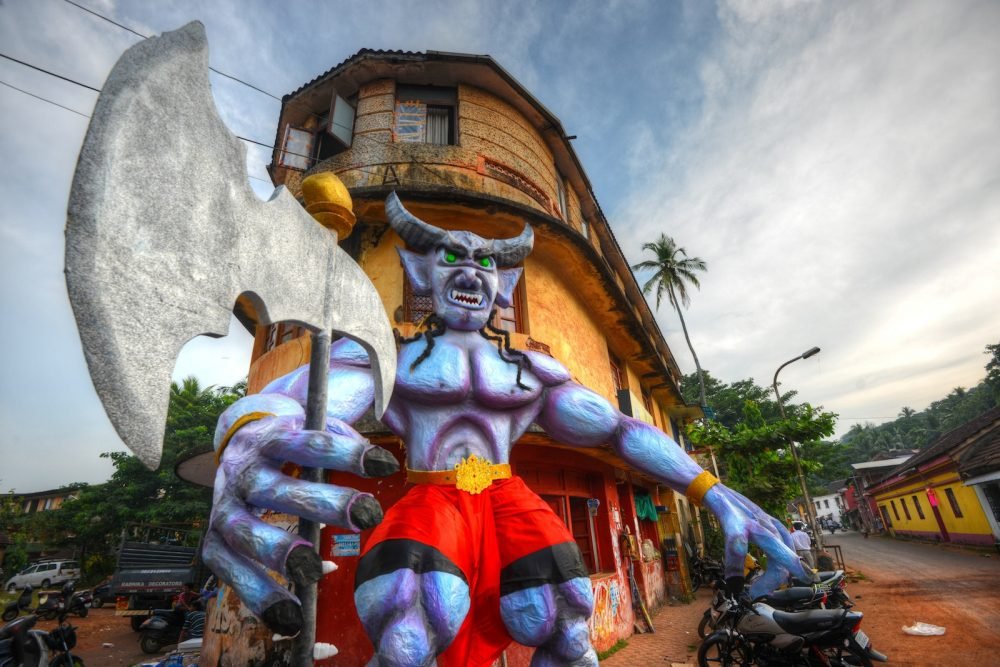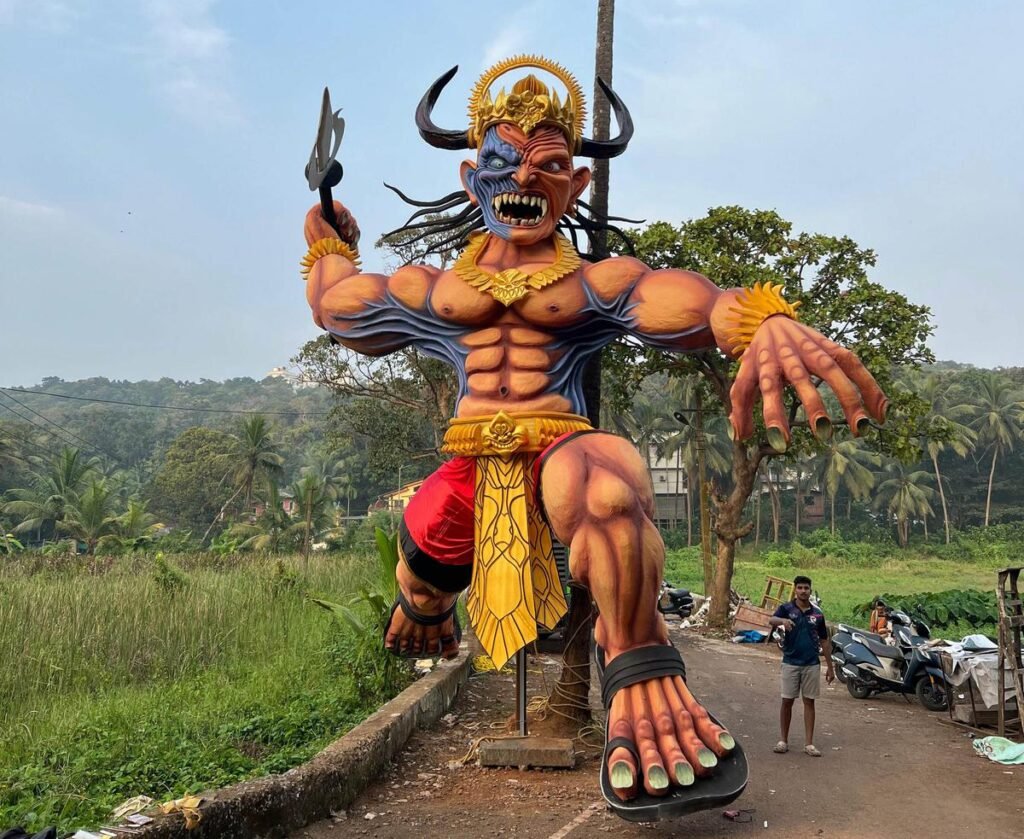Narak Chaturdashi Celebrations in Goa: An Ancient Tradition

Narak Chaturdashi, or Chhoti Diwali, has a special place in the elaborate cultural and religious festivities of Goa. It is celebrated on the eve of Diwali, signifying the victory of good over evil. The important celebration is found, yet the manner of celebrating it in Goa is unique and deeply tied to local lore and faith. On this day, Goans commemorate how Lord Krishna vanquished Narakasura, the demon, in the light, merriment, and solidarity of the community.

Indeed, what makes Goan celebrations unique is the formal burning of effigies of Narakasura. This spectacular tradition, replete with music, dance, and high spirits, signifies the area’s indelible divine fervour. Communities converge in temples and neighbourhoods to witness the flamboyant celebration, often a reenactment of victory over vice. As embedded in history, the festival of Narak Chaturdashi plays a major role in determining the festivity character of Goa today and tomorrow.
History of Narak Chaturdashi
Narak Chaturdashi is observed as another festival grounded in the mythology of Hinduism, featuring tales inspired by Lord Krishna, Satyabhama, and the demon Narakasura. Myths denote this festival as the one wherein good has triumphed over evil, wherein beginnings are marked by rejuvenation and light. Deeply embedded as a part of the Vaishnav practices, the festival has been observed for many years throughout India, especially Goa and Maharashtra during the past centuries.

The source of Goa’s strong association with the festival traces back to the demon Narakasura, who is alleged to have ruled the area. Narakasura was a symbol of oppression throughout generations, thus corrupt reign and denoted by his defeat by Krishna were symbolic of liberation, hope, and restoration of justice within fear and tyranny.
Though colonization by the Portuguese from the 16th to the 20th century altered some Hindu customs, Narak Chaturdashi continued to be of utmost importance and significance. In contemporary times, it is an energetic cultural event that celebrates local heritage as communities come together to reenact the story of Krishna’s destruction of Narakasura.

Rituals Performed in Narak Chaturdashi
Effigy Burning of Narakasura: The festival is more symbolically emphasized in Goa through the ceremonial burning of huge effigies of Narakasura, an evil spirit. These figures, often towering several feet high, are crafted weeks in advance using bamboo, paper, and straw. The nights of Narak Chaturdashi make ecstatic sounds resounding through the streets, where the effigies, bedecked with beautiful clothes, are carried accompanied by music, firecrackers, and drums. In the morning, evil was set ablaze, and darkness and ignorance were extinguished.
Such scenery mainly renders it irresistible to cities like Panaji, Margao, Vasco da Gama, and Mapusa, where local communities vie among themselves to construct the biggest, most well-decorated effigies. Great throngs gather to watch its collapse into flames, celebrated with joy. This indicates a purification of the spirit and encourages individuals to drop negativity and begin anew.
Oil Bath and Puja: One aspect of Narak Chaturdashi is the initial oil bath. At pre-dawn on that day, families rise early, smear different kinds of fragrant oils and herbs over their bodies and bathe, all done to elude any impurities. This washing symbolizes this purification, thus preparing devotees for Diwali celebrations. After the bath, pujas are performed in homes whereby lamps are lit, and prayers are made to Giridhari Krishna, Lakshmi, and other deities. This puja includes Tulsi leaves and flowers owing to the person they are associated with wealth and well-being.

Lighting Diyas and Fireworks: In the evening, houses glow with earthen lamps known as diyas. This gives light to every corner; thus, darkness and ignorance are driven away. Since the ritualistic burning of effigies is made at dawn, the lighting of firecrackers welcomes the day. According to beliefs, the shining lamp and the bursting firework bring good energies while making bad spirits leave and prepare the house for the arrival of Diwali’s Lakshmi, the goddess of prosperity.
Mythology of Narak Chaturdashi
The tale relates to a demon called Narakasura, who was born of the goddess Bhumi Devi. Although Narakasura was born with divine grace from birth, he became prideful and evil. He was a conqueror of many kingdoms and a cruel tyrant, holding in his palace thousands of women captive. Unable to endure his tyranny any longer, the gods appealed to Lord Krishna. Krishna set out to do battle with Narakasura, assisted by Satyabhama as his consort. In the fierce battle that took place, Satyabhama proved the turning point in vanquishing the demon since she was regarded as a form of Bhumi Devi herself. After Krishna had killed Narakasura, the imprisoned women were free once more, and they lived again peacefully.

This victory took place on the fourteenth day (Chaturdashi) of the dark fortnight of the month of Ashwin modelled as Narak Chaturdashi. It relates the message that being freed from bondage is possible if force, righteousness, and justice find their combination under the willpower and divine grace to permit anyway.
Celebration of Narak Chaturdashi in Goa
Narak Chaturdashi finds an exhilarating celebration all over Goa; it’s the time that sees a number of locations turning into hubs marked with festivities.
- Panaji: Being the capital city, Panaji witnesses grand effigy-burning ceremonies that draw very huge crowds. The streets and open places are beautifully lit up, with processions lending a joyous festive atmosphere to them.
- Margao: Community celebrations are hosted at Margao, where families come together for the construction of effigies in observance of Narakasura’s demise.
- Vasco da Gama: In the port town of Vasco da Gama, contests are held for making the most creative effigies. On this occasion, the area explodes to life with ecstatic fireworks and street plays.
- Mapusa: An apt destination due to its vibrant market, Mapusa celebrates the festival with traditional customs and activities. Locally, the festival is celebrated by lighting diyas outside their homes.
Several temples dedicated to Krishna and other deities are performing special pujas on Narak Chaturdashi, with devotees offering prayers for happiness and prosperity.

Impact of Narak Chaturdashi in Goa’s Society
Narak Chaturdashi is a spiritual celebration where good triumphs over evil. It encourages people to introspect their inner shadows and seek personal growth. The burning of the effigy of Narakasura represents the annihilation of ego and ignorance, motivating people to embrace a more positive and virtuous way of living.
This festival is a part of Goa’s cultural heritage because it preserves traditions and community ties. It makes the local people feel like one entity because they are involved in the preparation of effigies and organizing the celebrations.
In Goa, Narak Chaturdashi marks the beginning of the celebration of Diwali. Thus, the joyful mood spreads throughout the coming days. The festival calls people to clean their homes and light diyas at home before Lakshmi comes to spread joy around.
In recent times, people have made efforts towards greener celebrations by adopting biodegradable materials for effigies and decreasing the use of firecrackers. This change symbolizes growing consciousness about the ecological consequences of festivals, driving communities to adopt more environmentally friendly practices.

Conclusion
Narak Chaturdashi in Goa is also said to symbolize the triumph of good over evil, light over darkness. Through this celebration, with its age-old epic of how Lord Krishna kills Narakasura, comes important teaching moments in justice, heroism, and reflection. The finest expressions of Goan cultural richness include the burning effigies, the oil bath early in the morning, lighting the lamps, and getting together for festal glee.
Apart from holding the spiritual significance of a redefined life, the celebrations of Narak Chaturdashi inspire integration among various communities and refresh memories of change that might happen for good. As Goa celebrates this lively festival, initiatives aimed at environmentally sustainable practices promise that the spirit of Narak Chaturdashi will be valued by future generations. Whether in the bustling streets of Panaji or the religious rituals in Margao, the festival is a priceless jewel to the heritage of Goa—reminding everybody of how light continues to conquer darkness.


